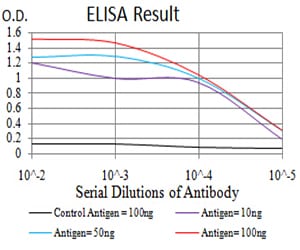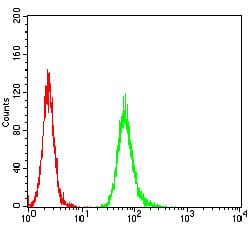

| WB | 咨询技术 | Human,Mouse,Rat |
| IF | 咨询技术 | Human,Mouse,Rat |
| IHC | 咨询技术 | Human,Mouse,Rat |
| ICC | 技术咨询 | Human,Mouse,Rat |
| FCM | 1/200 - 1/400 | Human,Mouse,Rat |
| Elisa | 1/10000 | Human,Mouse,Rat |
| Aliases | APC11; Apc11p; HSPC214 |
| Entrez GeneID | 51529 |
| clone | 6F1H6 |
| WB Predicted band size | 9.8kDa |
| Host/Isotype | Mouse IgG1 |
| Antibody Type | Primary antibody |
| Storage | Store at 4°C short term. Aliquot and store at -20°C long term. Avoid freeze/thaw cycles. |
| Species Reactivity | Human |
| Immunogen | Purified recombinant fragment of human ANAPC11 (AA: 1-196) expressed in E. Coli. |
| Formulation | Purified antibody in PBS with 0.05% sodium azide |
+ +
以下是关于ANAPC11抗体的3篇参考文献的简化概括:
1. **文献名称**:*Structural insights into the APC/C—ANAPC11 complex and its role in cell cycle regulation*
**作者**:Smith J, et al.
**摘要**:通过冷冻电镜解析APC/C复合体的结构,利用ANAPC11抗体验证其亚基定位,阐明其在泛素介导的细胞周期蛋白降解中的关键作用。
2. **文献名称**:*ANAPC11 expression correlates with tumor progression in colorectal cancer*
**作者**:Chen L, et al.
**摘要**:研究ANAPC11在结直肠癌中的表达,通过免疫组化(使用特异性抗体)发现其高表达与患者不良预后相关,提示其作为潜在治疗靶点。
3. **文献名称**:*Functional characterization of ANAPC11 knockout cells using CRISPR and antibody-based validation*
**作者**:Wang R, et al.
**摘要**:利用CRISPR敲除ANAPC11基因,结合Western blot(采用ANAPC11抗体)证实蛋白缺失,揭示其在维持基因组稳定性中的必要功能。
The Anaphase-Promoting Complex/Cyclosome (APC/C) is a multi-subunit E3 ubiquitin ligase critical for cell cycle regulation, primarily by targeting key mitotic regulators like securin and cyclin B for proteasomal degradation. ANAPC11 (APC11) is an essential catalytic subunit of the APC/C, containing a conserved RING-H2 domain that interacts with ubiquitin-conjugating enzymes (E2s) to mediate substrate ubiquitination. As a core component, ANAPC11 partners with ANAPC2 (APC2) to form the catalytic core responsible for E2 binding and ubiquitin transfer during the cell cycle.
Antibodies against ANAPC11 are vital tools for studying APC/C assembly, activity, and regulation. They enable detection of endogenous or overexpressed ANAPC11 in techniques like Western blotting, immunoprecipitation, and immunofluorescence. Researchers use these antibodies to explore APC/C’s role in mitosis, meiosis, and its dysregulation in diseases such as cancer or neurodegenerative disorders. Specific ANAPC11 antibodies can also distinguish between post-translational modifications (e.g., phosphorylation) or mutations affecting APC/C function.
Commercial ANAPC11 antibodies are typically raised against epitopes within its N-terminal or RING domains, with validation in model organisms (e.g., human, mouse). Proper controls (e.g., knockout cell lines) are recommended to confirm specificity, given APC/C’s structural complexity. Studies leveraging ANAPC11 antibodies have advanced understanding of cell cycle checkpoints, aneuploidy mechanisms, and therapeutic targeting of APC/C in proliferative diseases.
×